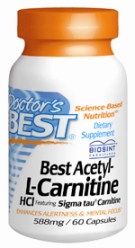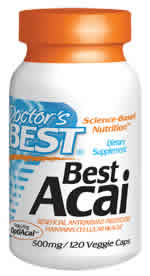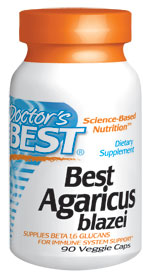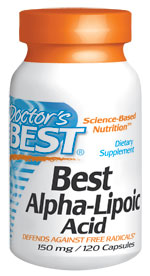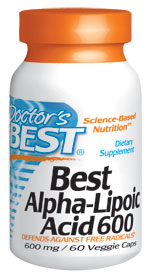| Acetyl-L-Carnitine (ALC) is a naturally occurring form of L-Carnitine, a vitamin-like nutrient synthesized in the body from the amino acids lysine and methionine. ALC serves as a transport molecule for "active acetate," which is a source of fuel for metabolic processes that take place in cells. ALC carries active acetate (the "Acetyl" portion) directly into the mitochondrion, the cell's energy-generating structure. Active acetate is used to produce cellular energy in the form of ATP. Both L-Carnitine and ALC serve as fat carriers. Unlike L-Carnitine, ALC readily crosses the blood-brain barrier, where it has specific benefits for brain neurons. When taken orally, ALC has been shown to increase ALC levels in both blood and cerebrospinal fluid, demonstrating its uptake in the brain.1
Best Acetyl-L-Carnitine consists of Biosint™ Acetyl-L-Carnitine, which is manufactured in Italy by the Sigma Tau company. It is derived from a base of pharmaceutical-grade L-Carnitine manufactured using an FDA-approved process that fully complies with international monograph standards for carnitine production. Known as a global leader in L-Carnitine research, Sigma Tau holds numerous patents for production of L-Carnitine, and its L-Carnitine derivatives, such as ALC, which are used in clinical trials.
Supports cognitive function*
ALC has been studied for its effect on cognitive performance and emotional health in the elderly. In a single-blind, placebo-controlled trial, 481 elderly subjects exhibiting mild memory impairment improved their scores on a memory test after taking 1500 mg of ALC a day for 90 days.2 Hospitalized elderly people taking ALC have shown improvements in mental outlook.3
While ALC is not a treatment or cure for Alzheimer's disease, double-blind studies suggest it may help slow the rate at which early-stage Alzheimer's patients deteriorate.4 In particular, ALC seems to benefit short-term memory in these patients.5
Supports biosynthesis of acetylcholine, a key neurotransmitter for brain and nerve function*
Brain function requires coordinated communication between brain cells. Brain and nerve cells ("neurons") communicate across tiny cell-to-cell gaps called "synapses." The passage of an electrical impulse from one neuron to the next requires a "neurotransmitter." When an electrical signal arrives at the synaptic junction, the neuron releases a neurotransmitter into the synapse. The neuron on the other side of the synapse contains receptors for the neurotransmitter; these receptors bind the neurotransmitter, triggering a series of chemical events that sends a new electrical signal down the membrane of the receiving neuron. Neurotransmitters work together like an orchestra to transmit information throughout the brain and nervous system.
Acetylcholine is the most abundant neurotransmitter in the body, regulating activities of vital organs, blood vessels and communication between nerves and muscles. In the brain, acetylcholine helps facilitate memory and learning as well as influence emotions. ALC is structurally similar to acetylcholine, and brain neurons stimulated by acetylcholine are receptive to stimulation by ALC.6 It has been shown experimentally that ALC supplies acetyl groups for the biosynthesis of acetylcholine.7 ALC's hypothesized cholinomimetic (acts like acetylcholine) activity has led researchers to investigate its effects on mental function and emotional health.8
Helps supply the brain with energy by improving energetics in the mitochondrion*
The acetyl groups donated by ALC can be used to synthesize acetyl-CoA, the key substrate for energy metabolism in the mitochondrion. 9 Acetyl-CoA enters the Krebs cycle, the mitochondrial mechanism that generates cellular energy in the form of ATP. ALC easily crosses the blood-brain barrier, allowing it to play various roles in maintaining brain neuron (nerve cell) function. When given by oral administration, the concentration of ALC is increased in the blood and cerebrospinal fluid.10
Stabilizes intracellular membranes*
ALC was found to improve membrane phospholipid metabolism in early-stage Alzheimer's patients.11 Phospholipids are structural components of brain cell membranes that regulate neuron function. ALC donates acetyl groups that can be used to modify the functional activity of proteins in neuronal membranes.12 ALC thus plays a role in maintaining membrane function. ALC also increases membrane stability and structural integrity.13
Increases nerve growth factor production*
The body produces various specialized proteins called "growth factors" which are essential to growth and repair of tissue. Nerve Growth Factor (NGF) protects neurons from death, prolonging survival of neurons in both the central and peripheral nervous systems. It is theorized that aging of the central nervous system is associated with a loss of NGF. ALC has shown the ability to reverse age-related decrease in the binding of NGF to its receptors in neuron membranes.14 Given to aged rats, ALC increases the level and utilization of NGF in the rats. ALC protects cholinergic neurons (nerve cells stimulated by acetylcholine) in rats from degeneration due to lack of NGF.15 These results, together with other data from animal studies, suggest that ALC positively influences NGF activity.16
Has a protective influence on brain neurons*
Several animal studies have revealed that ALC exerts a protective effect on neurons. In one experiment, brain cells from rats exposed to NMDA, a known neurotoxin, were protected by being simultaneously exposed to ALC.17 Rats injected with ALC were protected from mortality caused by the neurotoxin MPP+.18 ALC has been shown to raise levels of glutathione, a highly valuable antioxidant, in isolated mouse brain tissue.19 ALC prevents buildup of malondyhaldeyde, a marker of lipid peroxidation.20 ALC is also a chelator of iron, which can generate free radicals. It also reinforces antioxidant mechanisms in the brain.21
As a whole, data from test tube and animal studies, showing that ALC has a protective, restorative effect on brain neurons and neuronal energetic processes, suggest that ALC is an anti-aging nutrient for the brain. This hypothesis is supported by human studies demonstrating measurable benefits for brain function in elderly persons taking ALC by oral consumption.
Safety
Suggested Adult Use: 1 to 4 capsules daily.
ALC is considered safe and well-tolerated when consumed orally. ALC has been administered in doses as high as 3 grams per day for periods of two to six months, with no reports of serious side effects. Some patients have experienced occasional mild abdominal discomfort, nausea, skin rash, restlessness, vertigo and headache. The severity and incidence of these side effects are reported as minor.22
DOES NOT CONTAIN: milk, egg, wheat, corn, sugar, sweeteners, starch, salt, or preservatives.
Scientific References
1. Pettegrew, JW, Levine, J, McClure, RJ. Acetyl-L-carnitine physical-chemical, metabolic, and therapeutic properties: relevance for its mode of action in Alzheimer's disease and geriatric depression. Molecular Psychiatry 2000;5:616-32.
2. Salvioli, G. Neri , M. L-acetylcarnitine treatment of mental decline in the elderly. Drugs Exptl. Clin. Res. 1994; 20(4):169-76.
3. Tempesta, E, et al. L-acetylcarnitine in depressed elderly subjects. A cross-over study vs. placebo. Drugs Exptl. Clin. Res. 1987;8(7):417-23.
4. Spagnoli, A et al. Long-term acetyl-L-carnitine treatment in Alzheimer's disease. Neurology 1991;41:1726-32.
5. Rai, G et al. Double-blind, placebo-controlled study of acetyl-L-carnitine in patients with Alzheimer's dementia. Curr. Med Res. Opin. 1990;11:638-47.
6. Falchetto, S, Kato, G, Provini, L. The action of carnitines on cortical neurons. Can J Physiol Pharmacol 1971; 49(1):1:7.
7. Dolezal, V., Tucek, S. Utilization of citrate, acetylcarnitine, acetate, pyruvate and glucose for the synthesis of acetylcholine in rat brain slices. J Neurochem 1981;36(4):1323.30.
8. Passeri, M, et al. Mental impairment in aging: selection of patients, methods of evaluation and therapeutic possibilities of acetyl-L-carnitine. Int. J. Clin. Pharm. Res. 1988;8(5):367-76.
9. Pettegrew, JW, Levine, J, McClure, RJ. Acetyl-L-carnitine physical-chemical, metabolic, and therapeutic properties: relevance for its mode of action in Alzheimer's disease and geriatric depression. Molecular Psychiatry 2000;5:616-32.
10. Parnetti, L, et al. Pharmacokinetics of IV and oral acetyl-L-carnitine in multiple dose regimen in patients with senile dementia of Alzheimer type. Eur. J. Clin Pharmacol 1992;42:89-93.
11. Pettegrew, JW, et al. Clinical and neurochemical effects of acetyl-L-carnitine in Alzheimer's disease. Neurobiology of Aging 1995;16(1):1-4.
12. Pettegrew, JW, Levine, J, McClure, RJ. Acetyl-L-carnitine physical-chemical, metabolic, and therapeutic properties: relevance for its mode of action in Alzheimer's disease and geriatric depression. Molecular Psychiatry 2000;5:616-32.
13. Arduni, A, et al. Effect of L-carnitine and acetyl-L-carnitine on the human erythrocyte membrane stability and deformability. Life Sci 1990;47(26):2395-2400.
14. Taglialatela, G, et al. Stimulation of nerve growth factor receptors in PC12 by acetyl-L-carnitine. Biochem Pharmacol 1992;44(3):577-85.
15. Taglialatela, G, et al. Acetyl-L-carnitine treatment increases nerve growth factor levels and choline acetyltransferase activity in the central nervous system of aged rats. Exp Gerontol 1994;29(1):55-56.
16. Pettegrew, JW, Levine, J, McClure, RJ. Acetyl-L-carnitine physical-chemical, metabolic, and therapeutic properties: relevance for its mode of action in Alzheimer's disease and geriatric depression. Molecular Psychiatry 2000;5:616-32.
17. Forloni, G, Angeretti, N, Smiroldo, S. Neuroprotective activity of acetyl-L-carnitine: studies in vitro. J Neurosci Res 1994;37(1):92-6.
18. Steffen, V, et al. Effect of intraventricular injection of 1-methyl-4-phenylpyridinium: protection by acetyl-L-carnitine. Hum Exp Toxicol 1995;14(11):865-71.
19. Fariello, RG, et al. Systemic acetyl-L-carnitine elevates nigral levels of glutathione and GABA. Life Sci 1988;43(3):289-92.
20. Calvani, M, et al. Action of acetyl-L-carnitine in neurodegeneration and Alzheimer's disease. Ann Ny Acad Sci 1992;663:483-86.
21. Calvani, M, Carta, A. Clues to the mechanism of action of acetyl-L-carnitine in the central nervous system. Dementia 1991;2:1-6.
22. Zdanowicz, M. Acetyl-L-carnitine's healing potential. Continuing Education Module. New Hope Institute of Retailing. October, 2001. | 
